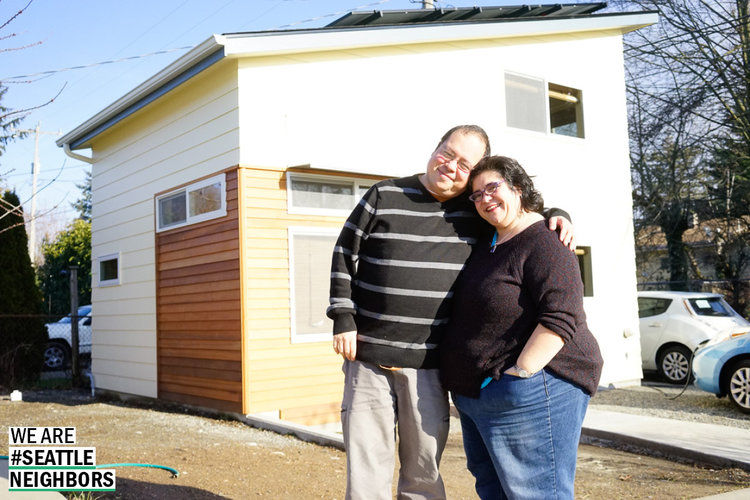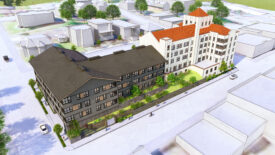ADUs can’t solve the region’s entire housing crisis, but these small homes could meet some of the need for the nearly 200,000 cost-burdened moderate- and low-income renter households in Oregon and Washington.
In Cascadia, a typical accessory dwelling unit (ADU) rents for about $1,300, affordable to a low- or middle-income household earning between 60 and 80 percent of the area median income (AMI). That makes ADUs, including granny flats, mother-in-law apartments, backyard cottages, and carriage houses, a form of low-cost market-rate housing. What’s more, over 10 percent of ADUs provide free housing to friends and family members of the ADU owner; many of these tenants may be living on even less than 50 percent of the AMI. It’s time to stop hamstringing ADU construction via unreasonable municipal code requirements and red tape, and instead allow these small homes to be a part of the solution to the region’s gaping affordable housing shortage.
Housing costs eat over 30 percent of the gross income of nearly 1.5 million households in Oregon and Washington—a full third of all households in these states—making them cost-burdened according to the US Department of Housing and Urban Development (HUD). Renters battle the most harsh statistics: nearly one in two renter households in Oregon and Washington are cost-burdened.
ADUs can’t solve the region’s entire housing crisis, but these small homes could meet some of the need for the nearly 200,000 cost-burdened moderate- and low-income renter households in Oregon and Washington, and perhaps also free up public housing funds for lower income households.
The rub is that local law books are often full of hurdles to ADU construction. So these homes may be technically legal across most of Cascadia, but many cities’ rules make it all but impossible for homeowners to actually build them. These local restrictions come in many flavors, including requiring off-street parking, limiting ADUs to just one per lot, and restrictions on size, height, setbacks, and design. All boost cost and complexity of ADU construction.
Striking some of the hurdles to ADU construction from Cascadia’s law books could reduce construction costs and allow more lots to accommodate ADUs. And the resultant boost in production would help fill some of the region’s yawning affordable housing gap.
And all this would come at the excellent price of free for local governments.
ADUs rent for less
Between 60 and 85 percent of homeowners use their ADUs to provide long-term housing to tenants. The majority of ADU owners set rent at levels affordable to low-income households. The US Department of Housing and Urban Development (HUD) defines housing as affordable when it costs no more than 30 percent of a household’s gross income, and considers households “cost-burdened” when they spend more than that 30 percent on housing. Nationally in the United States, over 6 million low- and moderate-income renter households are cost-burdened by their housing. Oregon and Washington are home to over 200,000 of these households, accounting for a little over 13 percent of all housing cost-burdened households in these states.
Definitions
Area median income (AMI): The median family income in the
metropolitan or nonmetropolitan area.
Extremely-low income: Households with income at or below the
Poverty Guideline or 30 percent of AMI, whichever is higher.
Very-low income: Households with income between 31 and 50 percent
of AMI.
Low income: Households with income between 51 and 80 percent of AMI.
Source: National Low Income Housing Coalition
A 2017 study of Cascadia’s ADU owners found that average ADU rent in the region hovered around $1,300 per month. That’s well below median rent in Portland and Seattle, which currently runs at over $1,500, and nearly $2,100 per month, respectively. According to HUD’s estimates, $1,300 monthly rent is affordable to a household in metro Portland earning 65 percent of AMI, or a metro Seattle area household earning about 60 percent of AMI (see methods note below).
Two older surveys of ADU owners within and beyond Cascadia, from 2012 and 2013, similarly found that ADUs typically rent at levels affordable to households earning less than 70 percent AMI at the time of each study.
Sometimes ADUs provide free homes
Though homeowners with ADUs typically set rent at a level affordable to a low-income household, some go even lower. Between 11 and 17 percent of ADU owners who have long-term tenants do not charge their tenants rent at all.
There’s no data on the income level of tenants who receive free housing via an ADU. But many of these tenants would likely be eligible for subsidized housing. They may be parents living on fixed incomes who need extra care, children looking for their first job and unable to cover a full rent check yet, or friends going through a transition in life and in need of a few months rent-free.
Many local jurisdictions in Cascadia and beyond are also experimenting with subsidized ADU programs for extremely low-income households, and I’ll review these in my next article in this series.
ADUs can free up affordable housing subsidy for more folks who need it
In addition to directly providing housing to low- and moderate-income households, ADUs also indirectly help reduce the housing crunch for households at the lowest rungs of the economic ladder.
Every low- or moderate-income household that can live in a non-subsidized ADU is one fewer household that needs public support. Municipalities then have the option of redirecting those saved funds to other households, and particularly those with incomes below 50 percent AMI. It’s difficult to calculate the exact magnitude of this effect, but as more ADUs enter Cascadia’s long-term rental market, they could enable a shift of the region’s affordable housing budget toward the people who need help the most.
A large share of public funds for housing subsidy are spent on people with incomes high enough to afford typical ADU rent. Washington state’s affordable housing funders, including the Housing Finance Commission and counties and cities across the state, spend between 20 and 50 percent of their budgets on housing affordable to households earning above 50 percent of the AMI. In 2017 the Washington Housing Finance Commission leveraged funds to build nearly 6,000 units of housing affordable to households earning above 60 percent AMI. Had the state had even a few thousand additional ADUs last year, some of those 6,000 publicly funded homes could have served additional households.
Similarly in Oregon, a large share of affordable housing funding serves low-income households. For example, in 2017 the state’s Local Innovation and Fast Track Housing (LIFT) program spent 45 percent of its approximately $20 million budget on housing for households above 50 percent AMI.
It’s important to note that at present public funding is far from keeping up with Cascadia’s enormous gap in affordable housing. So, though it’s possible that in the long-term ADUs could help shift housing budgets to focus more on households with incomes below 50 percent of AMI, more immediately they’d just help reduce the gap.
To contend with its affordable housing shortage, Cascadia will need to broaden its housing vision
Cascadia needs a more comprehensive vision of housing to tackle its ongoing affordability shortage. That means thinking outside the box for ways to create a broader range of housing types to meet the needs of diverse communities and households.
ADUs are just such a scrappy, outside the box idea. These small homes offer the opportunity to sprinkle affordable housing throughout residential neighborhoods, and put its management in the hands of individual homeowners who often charge below-market rate rents, and can nimbly respond to the unique needs of family and friends. What’s more, ADUs are an affordable housing solution that costs taxpayers nothing.
The path to making ADUs a bigger part of Cascadia’s housing solution lies in the pen: local jurisdictions can strike the regulations from their law books that add to ADU construction cost, but do nothing to protect health and safety. These regulations include quotas for off-street parking; caps on roommates who may share each single-family lot; restrictions on size, height, setbacks, and building design; allowances for just one ADU per lot; and costly fees. Tossing these barriers could boost ADU production, providing more homes to meet the needs of more Cascadians.
The potential for ADUs to play a part in easing the housing crisis doesn’t end here. In a future article I’ll explore some additional mechanisms local jurisdictions across the United States are piloting that use ADUs to provide homes for extremely-low income households.
But for now, let’s get scrappy.
Methods Note
In this article estimates regarding rental affordability are based on the US Department of Housing and Urban Development (HUD) income bracket definitions. HUD annually publishes its adjusted area median family income (HAMFI) calculations, which estimate median incomes for families in every state and metro region across the US. These adjusted area median income estimates are based on 5-year American Community Survey AMI estimates, and adjusted for the consumer price index (see this page for an example based on the Seattle metro area). HUD then further adjusts its estimates of income levels needed to afford housing based on household size, applying its basic adjusted AMI (HAMFI) calculation to a family of four. The data in this article are based on HAMFI’s 2018 base published numbers, those that apply to a household of four, including those for the Seattle metro area and Portland metro area.









